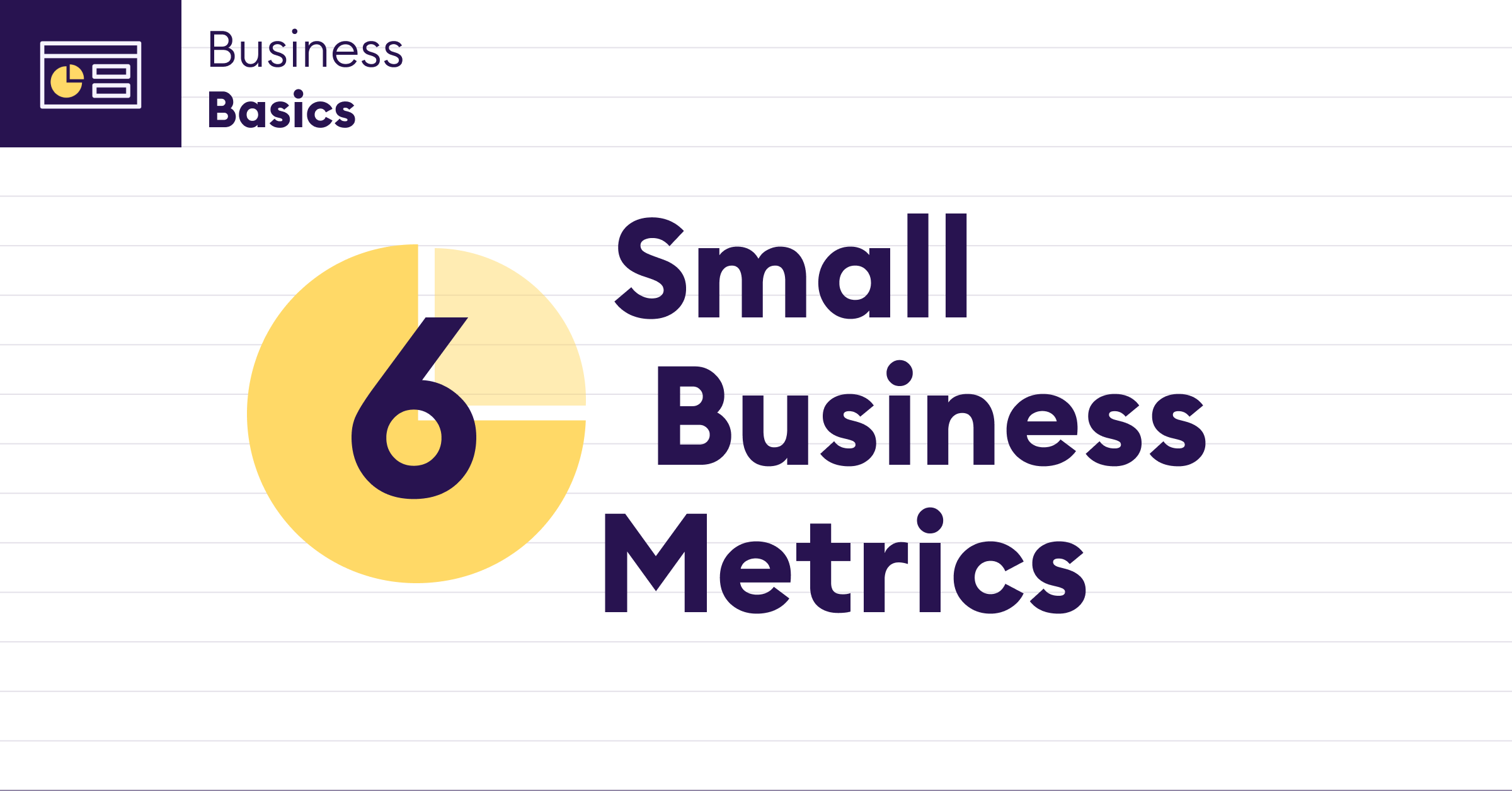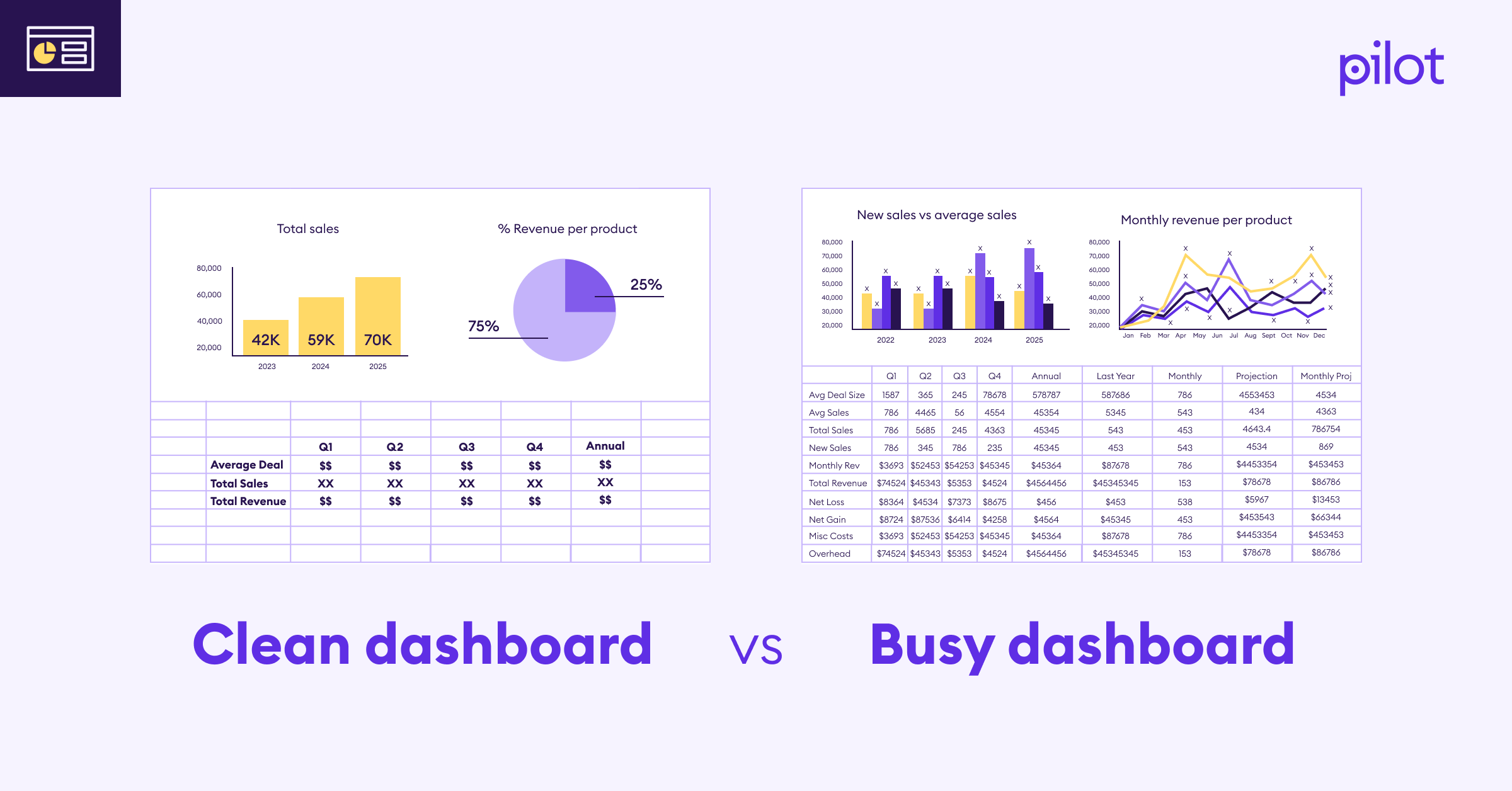The 6 small business metrics that matter and how to use them

Which metrics matter most for your small business? Don't be annoyed that our answer is “It depends.” But we promise that at the end of this guide, we’ll provide an exact answer. We first need to know more about your business.
Different metrics matter for different business models and at different stages. If you’re an agency, you won’t care about tracking out-of-stock items the way an ecommerce store does. And if you’re a new consulting firm, you won’t worry about tracking how effective your sales compensation plan is until you are larger, when that becomes critical.
At the end, we share a precise list of metrics likely to be useful to your business. These insights come from our bookkeeping and CFO Services teams that help hundreds of small business owners like yourself build dashboards and make decisions.
What you’ll learn:
- How to not waste time
- Metrics worth tracking
- How to use metrics to make decisions
- Metrics by industry
- Run a smarter business
How to avoid wasting time on the wrong performance metrics
The “best” metrics are always the ones that help you make decisions. That’s why you should only track numbers that you actually plan to use. Seriously, do not track everything you read in this guide. Hopefully, that’s a relief. The business owners we work with don’t need to track hundreds of metrics—just the ones that help them be successful.
That’s because more isn’t necessarily better.
1. If you can’t act on a metric, it’s just noise
A dashboard full of red and green gauges might feel insightful. But if you aren’t using that information to do something differently, it’s a distraction—like watching the stock market closely, but not actually being invested in any stocks.
2. If you track too much, you’ll feel paralyzed
Of these two dashboards pictured, which is easier to follow? Sometimes, less is more, and having too many metrics can mean you make no decision at all. Try to limit yourself to 3-4

3. Metrics cost you time and money
Tracking metrics isn’t free. They require you to upload or download spreadsheets or to maintain connections between QuickBooks and other apps. This means they take time, money, or both. The more key metrics you have, the greater the cost, and the greater chance those numbers don’t match and create a mess. Do track metrics—but track ones that are valuable enough to spend your time on.
This is all to say, do not obsess over things that don’t help you make decisions. Narrow in on figuring out what does.
Here are 6 key financial metrics every small business needs
Some metrics are universal. Every for-profit business has income and expenses. All must file taxes, and many have employees, and so must pay payroll. That means there is a good chance you will want to track some of the six metrics in the following table.
Note: Technically, for a number to be metric, it has to combine two numbers. Income is just a data point, but income per month is a metric.
Without the foundational data and reports listed above, it’s difficult to run a business. To build those reports, you need clean financial books, which you’ll need anyway to raise money, open bank accounts, file taxes, or prove your creditworthiness. Any small business just starting out should get its financial books and reporting in order.
How to choose the right metrics for your small business goals
Metrics should tell you what to do differently. If your goal is to grow, look at your overall income, how it changes month-over-month, and how it’s forecasted to grow. If your goal is to become more profitable, track your margins, net-retained revenue, and customer satisfaction.
As your goals change, so should your metrics. A retailer just getting off the ground is probably happy just to be making sales—whereas a well-established one will be more focused on gross margins and gross profit per SKU.
Ask yourself, “Am I trying to optimize what we have, or get bigger?” And are you new in your field or established?

Leading versus lagging metrics
You’ll also want to balance your metrics between two categories: Leading (how things are going) and lagging (how things went). Revenue is a classic lagging indicator. It’s how much money actually hit your bank account, or which you signed contracts for. Whereas pipeline is a leading indicator—it suggests how much revenue is coming.
Lagging indicators are truer, but you don’t measure them until after the month or quarter ends. Leading ones are more of a guess, but tell you what to do differently before it’s too late. To run a business, you need both.

The small business metrics worth tracking on your dashboard
Now let’s consider what fits on a dashboard, which you’ll look at daily, weekly, or monthly—and actually use.
Leading indicators help you plan ahead
These answer the question, “What should I do?”
- Headcount growth
- Pipeline
- Customer acquisition cost (CAC)
- Inventory levels
- Total invoices sent and unpaid
- Debt balance
Lagging indicators measure what’s working
These answer the question, ”How did it go?”
- Revenue for the trailing 12 months (TTM)
- Payroll TTM
- Expenses TTM
- Sales efficiency
- Current cash balance
Grouping small business metrics by function
Depending on the size of your business, you might also select key metrics for each business unit. For example:
- Go-to-market: Sales growth, marketing conversions
- Delivery: On-time orders, chargebacks, number of returns
- Operational: Headcount, return on capital
How to turn small business metrics into better decisions
The metrics on your dashboard are not exactly the truth. They’re just a proxy. Take revenue, for example: The “total revenue booked” number you see is the total amount customers owe you, but in reality, some will cancel, you’ll pay bank fees, and some customers will upgrade, so the actual number will always vary.
This matters because you must know those metrics well enough to know what to do if they fall. If you see your gross revenue falling, it helps to know how that number is collected. Instead of immediately sending collections invoices to customers, you might know that your bookkeeper is responsible for marking invoices as paid in QuickBooks, and has been out sick. So you may have been paid—it just doesn’t look like it.
Being an owner means developing a personal playbook for how to react to what the numbers tell you.
If you cannot connect a metric you have deemed important back to a “lever” you can pull, that’s worth investigating. Why is that beyond your control? How can you change that?
Over time, you develop an intuition about what changes in your key metrics mean. For example, let’s say you see your monthly sales fall at one location only. Is it the signage? Are there new competitors? Did a nearby big box store close down, which used to bring traffic? Then, based on your investigation, run the plays you know will help turn things around—running ads, adjusting the staffing schedule, using contractors, and the like.
Essential small business metrics by industry
Now let’s explore metrics “packages” useful to various industries. You’ll have to decide whether you are on the early or established side of these, and which metrics within each to pick.
Professional services like consultancies and agencies
- Current cash balance
- Forecasted cash balance
- Forecasted incoming cash
- Total invoices sent and unpaid
- Debt balance and interests
- Forecasted debt payment
- Invoices sent and cash received
- Payroll payments by month, broken down by individual
- Hours per person per project/client

Ecommerce, consumer goods, and retail
- Topline metrics
- Gross sales
- Net sales
- Sales dilution rate
- Average order value
- Repeat rate
- Return rate
- Unit economics
- Gross profit
- Contribution margin
- Inventory turnover ratio
- Marketing and website metrics
- Customer acquisition cost (CAC)
- Marketing as a percentage of sales
- Customer lifetime value
- Customer acquisition costs
- Customer retention cost
- Traffic
- Site conversion rate
- Basket size
- Funnel metrics
Food and beverage
- Unit economics
- Cost of goods sold
- Gross profit margin
- Menu item profitability
- Break-even point
- Marketing and sales
- Customer acquisition cost (CAC)
- Customer retention rate
- Customer satisfaction
- Operations
- On-time deliveries
- Employee turnover rate
How to build on your metrics and run smarter
Some small business owners run into a knowledge gap around metrics—they know how their business runs, but turning it into Excel models with buttons and macros? They simply don’t have the time. That’s where it can be very useful to find a fractional CFO or similar partner who does this for a living. There are 33 million small businesses in the U.S. and likely, if you want to track something, someone’s done something similar before.
To build on your great metrics work, consider reading:
- Bookkeeping checklist: What every small business needs
- Bookkeeping basics for small business owners
- How small business owners can use AI to save time and boost productivity
Key takeaways
The key takeaways about the most important metrics are this:
- Don’t track numbers you don’t plan to use.
- Get a bookkeeper to set up your data foundation right.
- Select 3-4 key metrics that matter most (with sub-metrics).
- Build a dashboard and know how to update it.
- Tailor that basket of metrics to your business and growth stage.
FAQs about small business metrics
What are the most important small business performance metrics to track?
Pick 3-4 key metrics that tell you how you are doing toward your goal. Depending on that goal, you’ll pick different metrics. If you are growing the business, focus on new revenue. If you are optimizing the business, focus on retained revenue or customer satisfaction. It also may go without saying, but tailor that list based on the nature of your business.
What’s the difference between leading and lagging indicators?
A leading indicator tells you how things are currently going, such as sales pipeline or website traffic. Lagging indicators tell you how things went—how many sales you actually closed or how many website visitors actually purchased. Every business needs a mix of both.
How often should small business owners review metrics?
Most small business owners look at their metrics daily. It’s a useful view of how it’s performing financially, which can help tell you where to focus your attention. (Usually, on what’s not going well.)
How do I know if I'm tracking too many metrics?
List them right now off the top of your head. If you had to look away and really think about it, it’s probably too many. But the real assessment is, do they help you run your business? It’s difficult to answer “Yes” when you can’t recall them all. You can have many sub-metrics, but try to stick to 3-4 key metrics.
Can I automate my small business metrics tracking?
To a degree, yes. The best way to do this is to have a fractional CFO build you a Google Sheets model that they maintain by uploading reports from your various systems, like QuickBooks, Shopify, Rippling, Stripe, and Gusto.




.png)
